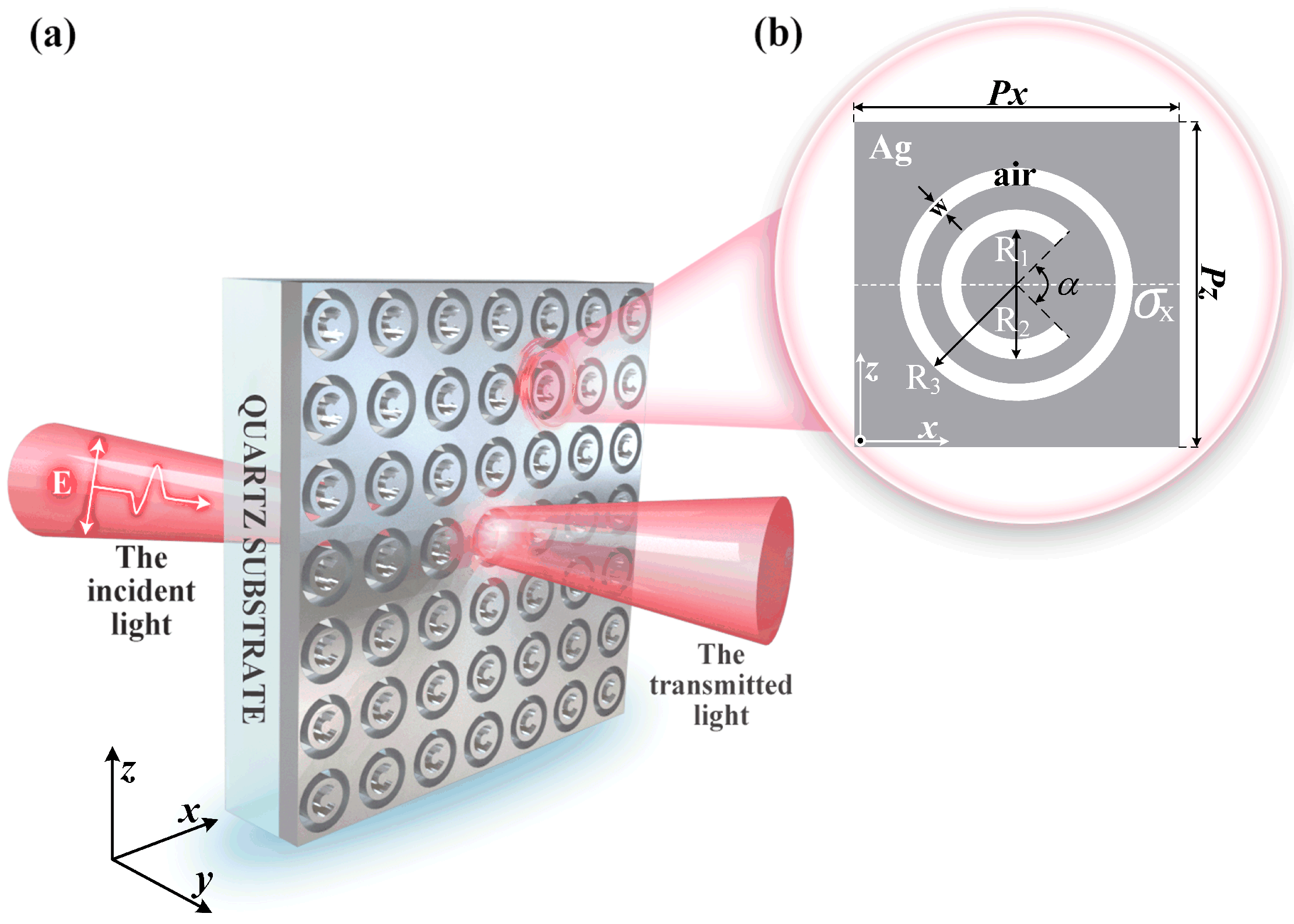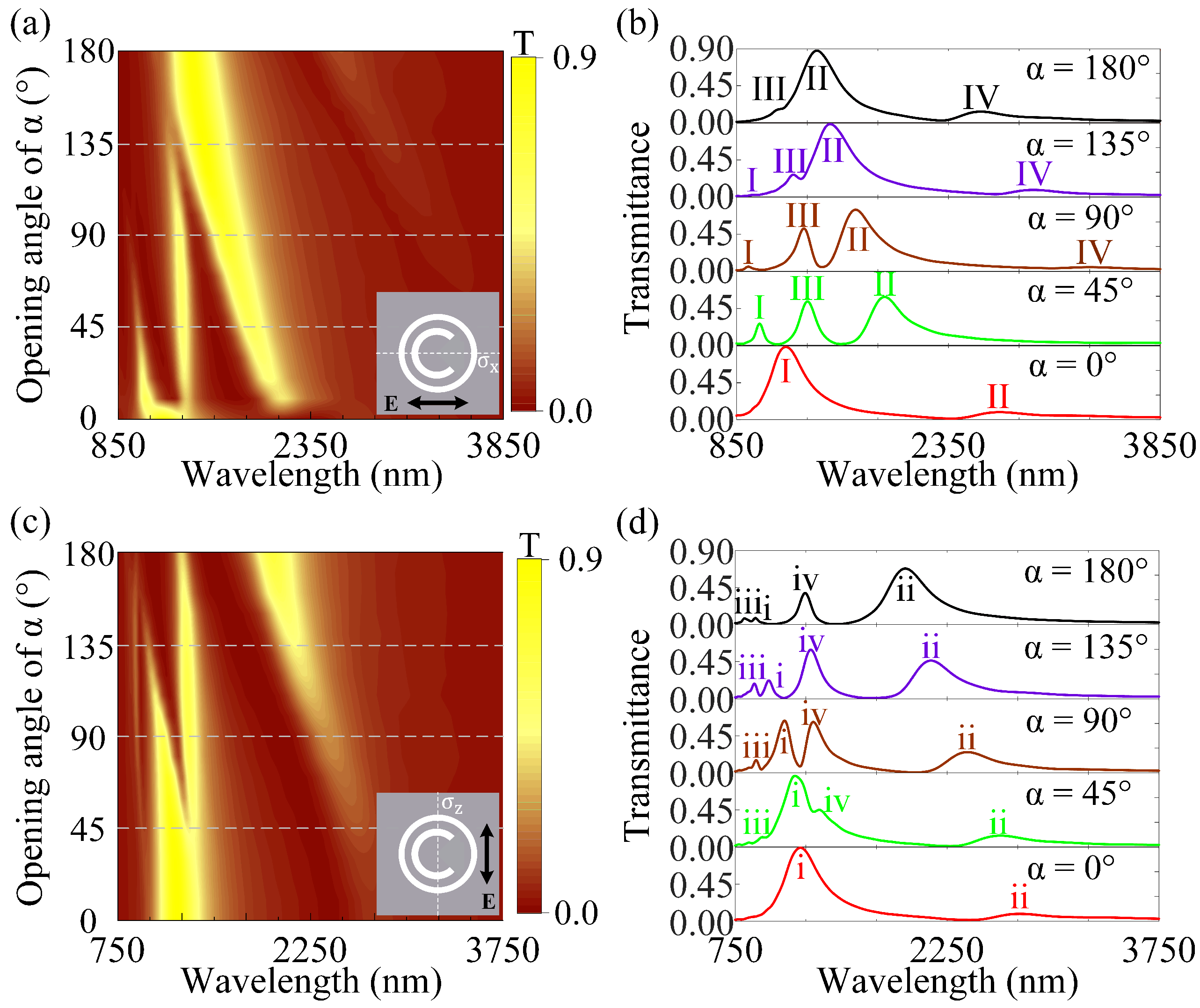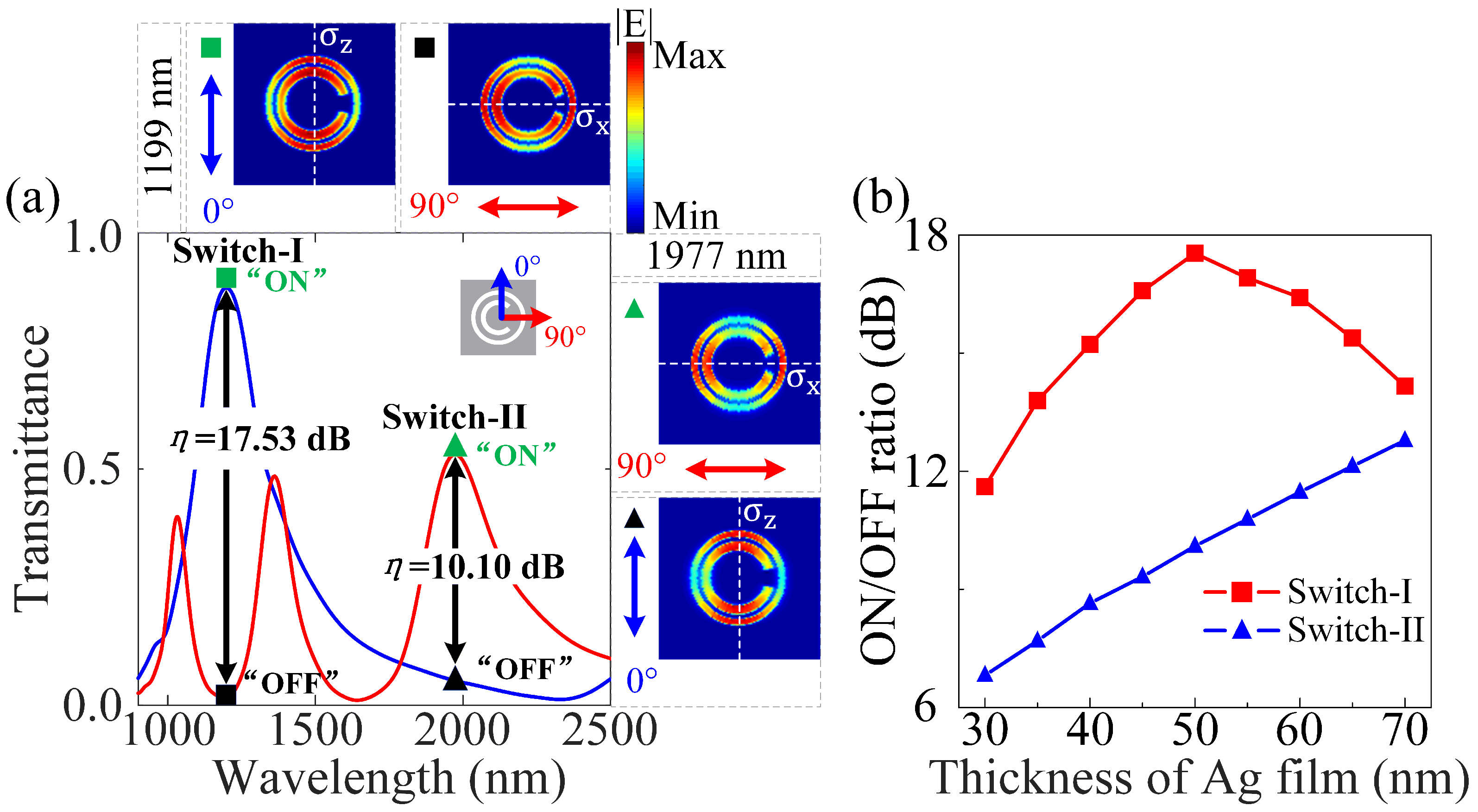Plasmonic Sensing and Switches Enriched by Tailorable Multiple Fano Resonances in Rotational Misalignment Metasurfaces
Abstract
1. Introduction
2. Structure and Model
3. Results and Discussion
3.1. Plasmonic Double Fano Resonances in a Hybrid Rotational Misalignment Metasurface
3.2. The Tailorable Plasmonic Multiple FRs with In-Plane Mirror Symmetry or Mirror Asymmetry
3.3. Plasmonic Sensing with In-Plane Mirror Symmetry and Mirror Asymmetry
3.4. Dual-Wavelength Plasmonic Switches with In-Plane Mirror Symmetry and Mirror Asymmetry
4. Conclusions
Author Contributions
Funding
Institutional Review Board Statement
Informed Consent Statement
Data Availability Statement
Conflicts of Interest
References
- Valentine, J.; Zhang, S.; Zentgraf, T.; Ulin-Avila, E.; Genov, D.A.; Bartal, G.; Zhang, X. Three-dimensional optical metamaterial with a negative refractive index. Nature 2008, 255, 376–379. [Google Scholar] [CrossRef]
- Li, Y.; Kita, S.; Muñoz, P.; Reshef, O.; Vulis, D.I.; Yin, M.; Lončar, M.; Mazur, E. On-chip zero-index metamaterials. Nat. Photonics 2015, 9, 738–742. [Google Scholar] [CrossRef]
- Hu, J.; Bandyopadhyay, S.; Liu, Y.H.; Shao, L.Y. A review on metasurface: From principle to smart metadevices. Front. Phys. 2021, 8, 58087. [Google Scholar] [CrossRef]
- Karimi, E.; Schulz, S.A.; De Leon, I.; Qassim, H.; Upham, J.; Boyd, R.W. Generating optical orbital angular momentum at visible wavelengths using a plasmonic metasurface. Light. Sci. Appl. 2014, 3, e167. [Google Scholar] [CrossRef]
- Kim, J.; Yang, Y.; Badloe, T.; Kim, I.; Yoon, G.; Rho, J. Geometric and physical configurations of meta-atoms for advanced metasurface holography. InfoMat 2021, 3, 739–754. [Google Scholar] [CrossRef]
- Narushima, T.; Hashiyada, S.; Okamoto, H. Nanoscopic study on developing optical activity with increasing chirality for two-dimensional metal nanostructures. ACS Photonics 2014, 1, 732–738. [Google Scholar] [CrossRef]
- Kim, K.H.; Kim, J.R. High-Q chiroptical resonances by quasi-bound states in the continuum in dielectric metasurfaces with simultaneously broken in-plane inversion and mirror symmetries. Adv. Opt. Mater. 2021, 9, 2101162. [Google Scholar] [CrossRef]
- Chen, Y.; Chen, W.J.; Kong, X.H.; Wu, D.R.; Chu, J.; Qi, C.W. Can weak chirality induce strong coupling between resonant states? Phys. Rev. Lett. 2022, 128, 146102. [Google Scholar] [CrossRef] [PubMed]
- Dou, K.H.; Xie, X.; Pu, M.B.; Li, X.; Ma, X.L.; Wang, C.T.; Luo, G.X. Off-axis multi-wavelength dispersion controlling metalens for multi-color imaging. Opto-Electron. Adv. 2020, 3, 190005. [Google Scholar] [CrossRef]
- Xu, X.F.; Luo, X.Q.; Zhang, J.Z.; Zhu, W.H.; Chen, Z.Y.; Li, T.F.; Liu, W.M.; Wang, X.L. Near-infrared plasmonic sensing and digital metasurface via double Fano resonances. Opt. Express 2022, 30, 5879–5895. [Google Scholar] [CrossRef]
- Luk’yanchuk, B.; Zheludev, N.I.; Maier, S.A.; Halas, N.J.; Nordlander, P.; Giessen, H.; Chong, C.T. The Fano resonance in plasmonic nanostructures and metamaterials. Nat. Mater. 2010, 9, 707–715. [Google Scholar] [CrossRef]
- Miroshnichenko, A.E.; Flach, S.; Kivshar, Y.S. Fano resonances in nanoscale structures. Rev. Mod. Phys. 2010, 82, 2257. [Google Scholar] [CrossRef]
- Liu, L.; Liu, K.; Liu, N.; Zhu, Z.; Zhang, J. Fano-resonant metasurface with 92% reflectivity based on Lithium Niobate on insulator. Nanomaterials 2022, 12, 3849. [Google Scholar] [CrossRef]
- Cao, G.T.; Dong, S.H.; Zhou, L.M.; Zhang, Q.; Deng, Y.; Wang, C.; Zhang, H.; Chen, Y.; Qiu, C.W.; Liu, X.K. Fano resonance in artificial photonic molecules. Adv. Opt. Mater. 2020, 8, 1902153. [Google Scholar] [CrossRef]
- Luo, X.Q.; Wang, D.L.; Zhang, Z.Q.; Ding, J.W.; Liu, W.M. Nonlinear optical behavior of a four-level quantum well with coupled relaxation of optical and longitudinal phonons. Phys. Rev. A 2011, 84, 033803. [Google Scholar] [CrossRef]
- Cerjan, B.; Gerislioglu, B.; Link, S.; Nordlander, P.; Halas, N.J.; Griep, M.H. Towards scalable plasmonic Fano-resonant metasurfaces for colorimetric sensing. Nanotechnology 2022, 33, 405201. [Google Scholar] [CrossRef] [PubMed]
- Zhang, S.; Zhou, J.F.; Park, Y.S.; Rho, J.; Singh, R.; Nam, S.; Azad, A.K.; Chen, H.T.; Yin, X.B.; Taylor, A.J.; et al. Photoinduced handedness switching in terahertz chiral metamolecules. Nat. Commun. 2012, 3, 942–948. [Google Scholar] [CrossRef] [PubMed]
- Ou, J.; Luo, X.Q.; Luo, Y.L.; Zhu, W.H.; Chen, Z.Y.; Liu, W.M.; Wang, X.L. Near-infrared dual-wavelength plasmonic switching and digital metasurface unveiled by plasmonic Fano resonance. Nanophotonics 2021, 10, 947–957. [Google Scholar] [CrossRef]
- Liu, S.D.; Yang, Z.; Liu, R.P.; Li, X.Y. Multiple Fano resonances in plasmonic heptamer clusters composed of split nanorings. ACS Nano 2012, 6, 6260–6271. [Google Scholar] [CrossRef] [PubMed]
- Lassiter, J.B.; Sobhani, H.; Fan, J.A.; Kundu, J.; Capasso, F.; Nordlander, P.; Halas, N.J. Fano resonances in plasmonic nanoclusters: Geometrical and chemical tunability. Nano Lett. 2010, 10, 3184–3189. [Google Scholar] [CrossRef] [PubMed]
- Gu, P.; Guo, Y.H.; Chen, J.; Zhang, Z.X.; Yan, Z.D.; Liu, F.X.; Tang, C.J.; Du, W.; Chen, Z. Multiple sharp Fano resonances in a deep-subwavelength spherical hyperbolic metamaterial cavity. Nanomaterials 2021, 11, 2301. [Google Scholar] [CrossRef] [PubMed]
- Hu, H.; Lu, X.; Huang, J.; Chen, K.; Su, J.; Yan, Z.; Tang, C.; Cai, P. Double narrow Fano resonances via diffraction coupling of magnetic plasmon resonances in embedded 3D metamaterials for high-quality sensing. Nanomaterials 2022, 11, 3361. [Google Scholar] [CrossRef] [PubMed]
- Liu, Z.G.; Xu, Y.; Ji, C.Y.; Chen, S.S.; Li, X.P.; Zhang, X.D.; Yao, Y.G.; Li, J.F. Fano-enhanced circular dichroism in deformable stereo metasurfaces. Adv. Mater. 2020, 32, 1907077. [Google Scholar] [CrossRef]
- Wu, C.H.; Arju, N.; Kelp, G.; Fan, J.A.; Dominguez, J.; Gonzales, E.; Tutuc, E.; Brener, I.; Shvets, G. Spectrally selective chiral silicon metasurfaces based on infrared Fano resonances. Nat. Commun. 2014, 5, 3892. [Google Scholar] [CrossRef] [PubMed]
- Besbes, M.; Hugonin, J.P.; Lalanne, P.; Van Haver, S.; Janssen, O.T.; Nugrowati, A.M.; Xu, M.; Pereira, S.F.; Urbach, H.P.; Van de Nes, A.S.; et al. Numerical analysis of a slit-groove diffraction problem. J. Eur. Opt. Soc. Rap. Public 2007, 2, 07022. [Google Scholar] [CrossRef]
- Xu, Y.; Chen, L.; Wang, X.C.; Yao, W.T.; Zhang, Q. Recent advances in noble metal based composite nanocatalysts: Colloidal synthesis, properties, and catalytic applications. Nanoscale 2015, 7, 10559–10583. [Google Scholar] [CrossRef] [PubMed]
- McMahon, J.M.; Henzie, J.; Odom, T.W.; Schatz, G.C.; Gray, S.K. Tailoring the sensing capabilities of nanohole arrays in gold films with Rayleigh anomaly-surface plasmon polaritons. Opt. Express 2007, 15, 18119–18129. [Google Scholar] [CrossRef] [PubMed]
- Zhen, F.H.; Chen, Z.Z.; Zhang, J.Z. Toward the development of a three-dimensional unconditionally stable finite-difference time-domain method. IEEE Trans. Microwave Theory Technol. 2000, 48, 1550–1558. [Google Scholar] [CrossRef]
- Chew, W.C.; Liu, Q.H. Perfectly matched layers for elastodynamics: A new absorbing boundary condition. J. Comput. Acous. 1996, 4, 341–359. [Google Scholar] [CrossRef]
- Muravitskaya, A.; Gokarna, A.; Movsesyan, A.; Kostcheev, S.; Rumyantseva, A.; Couteau, C.; Lerondel, G.; Baudrion, A.L.; Gaponenko, S.; Adam, P.-M. Refractive index mediated plasmon hybridization in an array of aluminium nanoparticles. Nanoscale 2020, 12, 6394–6402. [Google Scholar] [CrossRef]
- Zhang, S.P.; Bao, K.; Halas, N.J.; Xu, H.X.; Nordlander, P. Substrate-induced Fano resonances of a plasmonic nanocube: A route to increased-sensitivity localized surface plasmon resonance sensors revealed. Nano Lett. 2011, 11, 1657–1663. [Google Scholar] [CrossRef] [PubMed]
- Piao, X.; Yu, S.; Koo, S.; Lee, K.; Park, N. Fano-type spectral asymmetry and its control for plasmonic metal-insulator-metal stub structures. Opt. Express 2011, 19, 10907–10912. [Google Scholar] [CrossRef]
- Li, S.L.; Wang, Y.L.; Jiao, R.Z.; Wang, L.L.; Duan, G.Y.; Yu, L. Fano resonances based on multimode and degenerate mode interference in plasmonic resonator system. Opt. Express 2017, 25, 3525–3533. [Google Scholar] [CrossRef]
- Wang, J.Y.; Yang, W.M.; Sun, G.Y.; He, Y.L.; Ren, P.W.; Yang, Z.L. Boosting anapole-exciton strong coupling in all-dielectric heterostructures. Photonics Res. 2022, 10, 1744–1753. [Google Scholar] [CrossRef]
- Shi, W.Q.; Gu, J.Q.; Zhang, X.Y.; Xu, Q.; Han, J.G.; Yang, Q.L.; Cong, L.Q.; Zhang, W.L. Terahertz bound states in the continuum with incident angle robustness induced by a dual period metagrating. Photonics Res. 2022, 10, 810–819. [Google Scholar] [CrossRef]
- Lo, C.J.; Aref, T.; Bezryadin, A. Fabrication of symmetric sub-5 nm nanopores using focused ion and electron beams. Nanotechnology 2006, 17, 3264. [Google Scholar] [CrossRef]
- Shi, T.; Deng, Z.L.; Geng, G.Z.; Zeng, Y.X.; Hu, G.W.; Overvig, A.; Li, J.J.; Qiu, C.W.; Alù, A.; Kivshar, Y.S.; et al. Planar chiral metasurfaces with maximal tunable chiroptical response driven by bound states in the continuum. Nat. Commun. 2022, 13, 4111. [Google Scholar] [CrossRef]
- Li, X.F.; Bian, X.Y.; Milne, W.I.; Chu, D.P. Fano resonance engineering in mirror-symmetry-broken thz metamaterials. Appl. Phys. B 2016, 112, 1–11. [Google Scholar] [CrossRef]
- Špačková, B.; Wrobel, P.; Bocková, M.; Homola, J. Optical biosensors based on plasmonic nanostructures: A review. Proc. IEEE 2016, 106, 2380–2408. [Google Scholar] [CrossRef]
- Zhang, Z.; Zhang, Q.; Li, B.; Zang, J.; Cao, X.; Zhao, X.; Xue, C. Double Fano Resonance and Independent Regulation Characteristics in a Rectangular-like Nanotetramer Metasurface Structure. Nanomaterials 2022, 12, 3479. [Google Scholar] [CrossRef]
- Chang, W.-S.; Lassiter, J.B.; Swanglap, P.; Sobhani, H.; Khatua, S.; Nordlander, P.; Halas, N.J.; Link, S. A plasmonic Fano switch. Nano Lett. 2012, 12, 4977–4982. [Google Scholar] [CrossRef] [PubMed]
- Gerislioglu, B.; Bakan, G.; Ahuja, R.; Adam, J.; Mishra, Y.K.; Ahmadivand, A. The role of Ge2Sb2Te5 in enhancing the performance of functional plasmonic devices. Mater. Today Phys. 2020, 12, 100178. [Google Scholar] [CrossRef]
- Li, J.; Zhang, Y.T.; Li, J.N.; Yan, X.; Liang, L.J.; Zhang, Z.; Huang, J.; Li, J.H.; Yang, Y.; Yao, J.Q. Amplitude modulation of anomalously reflected terahertz beams using all-optical active Pancharatnam–Berry coding metasurfaces. Nanoscale 2019, 11, 5746–5753. [Google Scholar] [CrossRef]
- Li, G.-C.; Zhang, Q.; Maier, S.A.; Lei, D.Y. Plasmonic particle-on-film nanocavities: A versatile platform for plasmon-enhanced spectroscopy and photochemistry. Nanophotonics 2018, 7, 1865–1889. [Google Scholar] [CrossRef]
- Genç, A.; Patarroyo, J.; Sancho-Parramon, J.; Bastús, N.G.; Puntes, V.; Arbiol, J. Hollow metal nanostructures for enhanced plasmonics: Synthesis, local plasmonic properties and applications. Nanophotonics 2017, 6, 193–213. [Google Scholar] [CrossRef]
- Kang, L.; Jenkins, R.P.; Werner, D.H. Recent Progress in Active Optical Metasurfaces. Adv. Opt. Mater. 2019, 7, 1801813. [Google Scholar] [CrossRef]
- Gorkunov, M.V.; Antonov, A.A.; Tuz, V.R.; Kupriianov, A.S.; Kivshar, Y.S. Bound States in the Continuum Underpin Near-Lossless Maximum Chirality in Dielectric Metasurfaces. Adv. Opt. Mater. 2021, 9, 2100797. [Google Scholar] [CrossRef]
- Zhang, H.L.; Cao, P.F.; Dou, J.; Cheng, L.; Niu, T.M.; Zhang, G.M. Double-exponential refractive index sensitivity of metal–semiconductor core–shell nanoparticles: The effects of dual-plasmon resonances and red-shift. RSC Adv. 2018, 8, 1700–1705. [Google Scholar] [CrossRef]
- Xu, J.; Tang, J.; Cheng, Y.; Chen, M.; Wang, H.X.; Xiong, J.F.; Wang, T.R.; Wang, S.Z.; Zhang, Y.D.; Wen, H.; et al. Multifunctional analysis and verification of lightning-type electromagnetic metasurfaces. Opt. Express 2022, 30, 17008–17025. [Google Scholar] [CrossRef]
- Jiang, L.; Huang, Q.; Chiang, K.S. Low-power all-optical switch based on a graphene-buried polymer waveguide Mach-Zehnder interferometer. Opt. Express 2022, 30, 6786–6797. [Google Scholar] [CrossRef] [PubMed]
- Amin, M.; Ramzan, R.; Siddiqui, O. Fano resonance based ultra high-contrast electromagnetic switch. Appl. Phys. Lett. 2017, 110, 181904. [Google Scholar] [CrossRef]
- Chen, F.; Yao, D.Z. Tunable multiple all-optical switch based on multi-nanoresonator-coupled waveguide systems containing kerr material. Opt. Commun. 2014, 312, 143–147. [Google Scholar] [CrossRef]
- Mi, Q.; Sang, T.; Pei, Y.; Yang, C.Y.; Li, S.; Wang, Y.K.; Ma, B. High-quality-factor dual-band Fano resonances induced by dual bound states in the continuum using a planar nanohole slab. Nanoscale Res. Lett. 2021, 16, 150. [Google Scholar] [CrossRef] [PubMed]
- Holsteen, A.; Lin, D.; Kauvar, I.; Wetzstein, G.; Brongersma, M.L. A light-field metasurface for high-resolution single-particle tracking. Nano Lett. 2019, 19, 2267–2271. [Google Scholar] [CrossRef]
- Yang, S.; Hong, C.C.; Jiang, Y.; Ndukaife, J.C. Nanoparticle trapping in a quasi-bic system. ACS Photonics 2021, 8, 1961–1971. [Google Scholar] [CrossRef]
- Tittl, A.; John-Herpin, A.; Leitis, A.; Arvelo, E.R.; Altug, H. Metasurface-based molecular biosensing aided by artificial intelligence. Angew. Chem. Int. Ed. 2019, 58, 14810–14822. [Google Scholar] [CrossRef] [PubMed]






Publisher’s Note: MDPI stays neutral with regard to jurisdictional claims in published maps and institutional affiliations. |
© 2022 by the authors. Licensee MDPI, Basel, Switzerland. This article is an open access article distributed under the terms and conditions of the Creative Commons Attribution (CC BY) license (https://creativecommons.org/licenses/by/4.0/).
Share and Cite
Xu, X.; Luo, X.-Q.; Liu, Q.; Li, Y.; Zhu, W.; Chen, Z.; Liu, W.; Wang, X.-L. Plasmonic Sensing and Switches Enriched by Tailorable Multiple Fano Resonances in Rotational Misalignment Metasurfaces. Nanomaterials 2022, 12, 4226. https://doi.org/10.3390/nano12234226
Xu X, Luo X-Q, Liu Q, Li Y, Zhu W, Chen Z, Liu W, Wang X-L. Plasmonic Sensing and Switches Enriched by Tailorable Multiple Fano Resonances in Rotational Misalignment Metasurfaces. Nanomaterials. 2022; 12(23):4226. https://doi.org/10.3390/nano12234226
Chicago/Turabian StyleXu, Xiaofeng, Xiao-Qing Luo, Qinke Liu, Yan Li, Weihua Zhu, Zhiyong Chen, Wuming Liu, and Xin-Lin Wang. 2022. "Plasmonic Sensing and Switches Enriched by Tailorable Multiple Fano Resonances in Rotational Misalignment Metasurfaces" Nanomaterials 12, no. 23: 4226. https://doi.org/10.3390/nano12234226
APA StyleXu, X., Luo, X.-Q., Liu, Q., Li, Y., Zhu, W., Chen, Z., Liu, W., & Wang, X.-L. (2022). Plasmonic Sensing and Switches Enriched by Tailorable Multiple Fano Resonances in Rotational Misalignment Metasurfaces. Nanomaterials, 12(23), 4226. https://doi.org/10.3390/nano12234226




